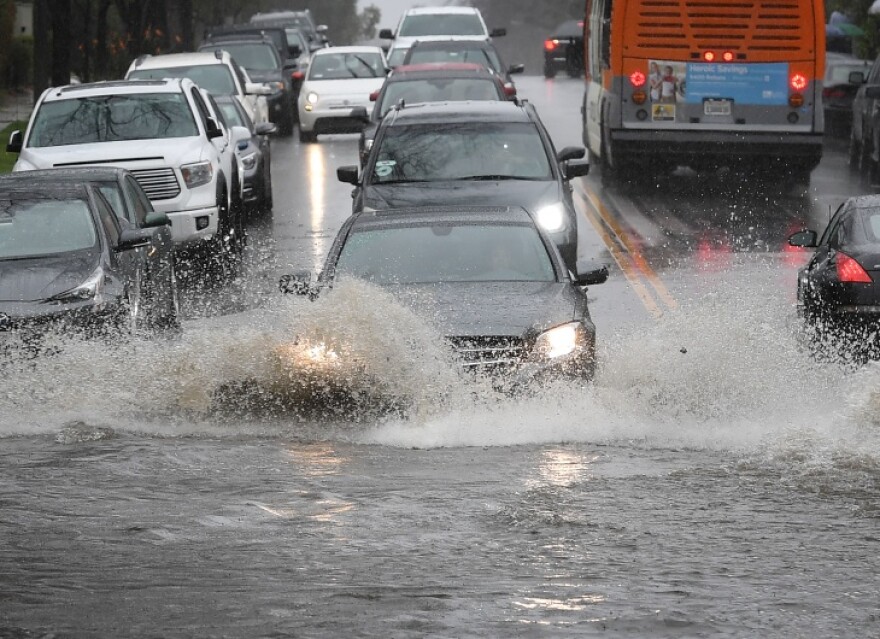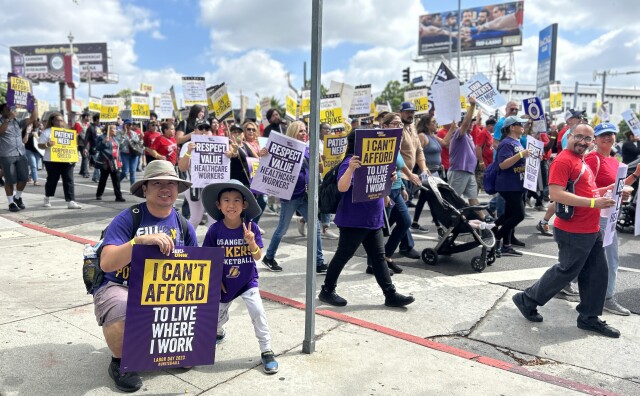Hey LA, The Worst Time To Drive In The Rain Is Probably Not When You Think

When it's raining, Los Angeles' roads are slick. So naturally there'd be more crashes when the roads are full, right?
Wrong. Researchers from USC's data journalism project Crosstown recently crunched traffic and weather data and found some weird patterns.
Breaking down L.A. County into 236 separate grids of 16 square miles, they tracked vehicle crashes and weather for each hour of the day between 2016 and 2018.
On dry days, they found that crashes tend to peak during rush hour, when there are more fender benders.
But on rainy days, the researchers discovered most crashes happen during the middle of the day — when there's less traffic.
It's counter-intuitive, but there's a good reason.
"Anything that allows you to travel at a normal speed when it's wet is going to dramatically increase the likelihood of a [crash]" said Gabriel Kahn, one of the researchers on the project.
He explained that drivers go too fast in the rain on an open road — and don't hit the brakes early enough.
The most dangerous hour to drive during wet weather? Between 11 a.m. and 12 p.m..

Crosstown researchers also found that drivers are 80% more likely to crash their cars when it rains.
California Highway Patrol information officer Juan Galvan said on a normal day, during peak driving hours, his office might get 30 to 40 calls — but when it rains, that number can shoot up to 150.
"It all comes down to speed," he said. "Sometimes the safe speed will probably be 40 miles per hour — but people are doing 50, 60, thinking they're still under the speed limit."
Drivers often don't realize that they're going too fast for the wet conditions.
Crosstown data researcher Mingxuan Yue said it's generally hard to compare traffic against weather in L.A. County because weather can both vary over the region and change quickly. He said just calculating the rainy and sunny days in a year doesn't work.
"Rain can happen at any hour of day and can disappear — or it can happen to a specific area and not to other areas in L.A. County," Yue said.
That's why the team decided to break down the city into grids and monitor weather and traffic conditions per hour to pinpoint the data.
So what's the safest hour to drive on a rainy day?
Crosstown researchers say it's during "the thick of the evening commute" — between 6 p.m. and 7 p.m., when traffic is already bumper-to-bumper.
Kahn said there are also other variables besides weather to consider when evaluating crashes. As people move farther out from the center of L.A. County in search of more affordable housing, that means more people are commuting to work, which increases their chances of a car crash.
And then there's the issue of drivers and technology.
"They're increasingly distracted with phones, with other devices," Kahn said, adding that he has to put his own phone in the trunk of his car when he drives.
But researchers say the best way to avoid a crash is pretty simple: just slow down.
-
After San Gabriel's city council rejected the proposal as "too narrow", one city councilmember argued the entire DEI commission, created in the aftermath of George Floyd's murder, had "run its course."
-
A medical industry challenge to a $25 minimum wage ordinance in one Southern California city suggests health workers statewide could face layoffs and reductions in hours and benefits under a state law set to begin phasing in in June. Some experts are skeptical, however, that it will have such effects.
-
Sandhill cranes are returning to the Lake Tahoe basin after a century long hiatus in what many say is a conservation success story.
-
The Dodgers fired Mizuhara in March after Ohtani's lawyers accused him of stealing millions of dollars from the baseball player to place bets with an Orange County-based bookie.
-
Jackie’s partner, Shadow, refuses to abandon their unviable eggs, despite her attempts to nudge him along.
-
Big Sur's Highway 1 was built to maximize the breathtaking views of the cliffs and ocean at the cost of the road's longterm stability.









